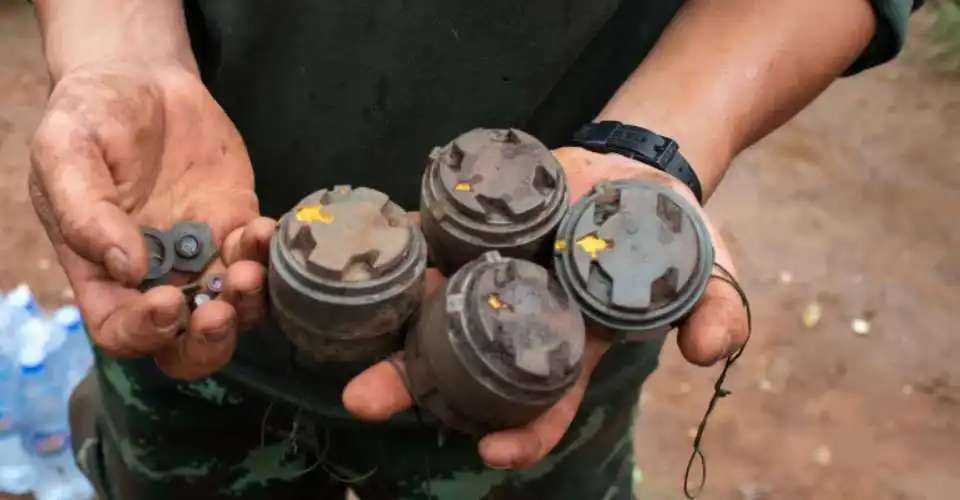
A file photo of landmines planted by the Myanmar military and removed during de-mining operations. (Photo: AFP)
Myanmar topped the global list of casualties from landmines last year, HRW said in a report released on Nov. 21.
The country had a total of 1,003 documented civilian deaths and injuries from landmines and explosive remnants of war in 2023, almost three times the previous year, the HRW report said.
The casualties resulted as fighting between the junta military and alliances of opposition and ethnic armed groups spiked nationwide last year, it said.
Landmine casualties and contamination have been documented for the first time in all 14 Myanmar states and regions, affecting about 60 percent of the country’s townships, it added.
This year, a total of 692 civilian casualties, about one-third children, from landmines were recorded in the first six months, and the actual numbers are presumed to be much higher.
The rise in landmine uses and soaring death toll in Myanmar should be strongly condemned by the countries expected to participate in the Mine Ban Treaty’s Fifth Review Conference from November 25-29 in Siem Reap, Cambodia, HRW said.
Besides, the international community should strengthen efforts to support victims of anti-personnel mines, it added.
“The Myanmar military’s widespread use of antipersonnel mines will threaten the lives and livelihoods of villagers now and for decades to come,” said Shayna Bauchner, Asia researcher at Human Rights Watch. “The junta’s planting of landmines in homes, villages, and farms appears designed to both terrorize and harm civilians.”
In October, Human Rights Watch interviewed four landmine survivors and six medical and humanitarian workers who provide support to victims. All four survivors lost one or both legs.
People interviewed described soldiers planting mines around houses and along pathways in villages emptied by fighting, imperiling residents upon return. Three victims said they were injured when returning to their villages or while fleeing.
Myanmar is one of only four countries actively using antipersonnel mines, along with Russia, Iran, and North Korea, HRW said.
The Myanmar military has long used antipersonnel mines, but new use has increased since the February 2021 coup amid the junta’s campaign of war crimes and crimes against humanity, it said. Non-state armed groups have also used antipersonnel mines, often improvised, and have stockpiled junta-produced mines collected in the field.
The junta’sDirectorate of Defence Industries, known as KaPaSa, produces at least five types of antipersonnel mines, including blast mines, stake mines, Claymore-type directional mines, and bounding fragmentation mines., the report said.
Mines have been planted at schools, medical clinics, monasteries and churches, plantations, cell towers and power stations, displacement camps, ports, development projects, and bridges.
Military units have increasingly rounded up villagers to act as “human minesweepers,” including children, forcing them to walk ahead of troops to detonate any explosives. “Sometimes they force them to wear military uniforms,” said a doctor who travels to conflict regions. “If they’re injured, they’re just left to die.”
Daw Khin, 57, stepped on a landmine near her toilet, two days after returning from a displacement camp in September 2022, she told HRW.
She had fled military airstrikes over a year earlier. “I went back to clean like many other villagers,” she said. “I didn’t think the military would lay mines in my house.”
She was unconscious for three days, during which doctors amputated her entire right leg, lower left leg, and finger. “I was crying for weeks and so depressed… I’m still in pain. I feel numbness all the time.”
Myanmar’s conflict has internally displaced more than 3 million people since the coup, including over 1.8 million since October 2023. The growing contamination of landmines and unexploded ordnance threatens their return, HRW said.
